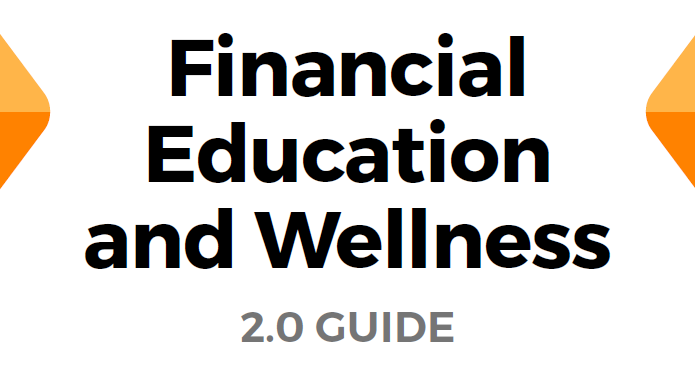The downloadable version of this guide is available here.
Financial education and wellness are big topics these days. Anyone reading this guide has likely heard statistics about how many people live paycheck to paycheck or how few people have $600 socked away for an emergency.
With ongoing talk of recession, high inflation, soaring consumer good costs, high interest rates, stagnant wages, and many high-profile reductions in force (mass layoffs), consumers are feeling the squeeze. What a time for student loan repayments to resume, right?
In this guide, we’ll try to accomplish the following:
- Define “financial education,” “financial literacy,” and “financial wellness”;
- Analyze trends pertaining to the above;
- Introduce fintechs—competitors and partners alike—that address financial education and wellness;
- Group fintechs according to whether they want to eat your lunch, sell you lunch, or eat lunch with you;
- Score fintechs by their impact on 4 key variables:
- Income statement
- Balance sheet
- Members
- Employees
We will also provide some evaluation criteria that you can use when searching for your partner. The criteria—and the guide as a whole—are meant to serve as a starting point for your credit union’s search for a best-fit solution.
Finally, please note that our scores and grouping are estimations and are not ratings of quality or fit.
Definitions and Disambiguation
First, how do we define financial education and literacy?
We define financial literacy as the understanding and knowledge of various financial concepts, such as budgeting, investing, borrowing, saving, and the general workings of the financial system. Financial education is the process of training people to be financially literate.
In essence, financial literacy is about being informed on financial matters, knowing the difference between debit and credit, understanding how interest rates work, or learning what goes into their credit score.
For consumers, financial literacy is essential because it equips them with the tools and understanding necessary to make informed decisions about their money. Whether it’s budgeting basics, retirement savings strategy, understanding the implications of taking out a loan, or navigating the world of credit cards, being financially literate can lead to better financial outcomes and fewer costly mistakes. Credit unions, as member-driven institutions, have a vested interest in ensuring their members are financially literate. When members understand their finances, they’re more likely to make prudent decisions, reducing the risk of default on loans or falling into debt traps. Additionally, by offering financial literacy programs, credit unions can position themselves as trusted advisors, deepening member relationships and loyalty.
Second, how do we define financial wellness?
Financial wellness goes a step beyond mere understanding; it’s about an individual’s overall financial health and well-being. This encompasses not just knowledge, but also the confidence and resilience to effectively manage one’s finances, live within one’s means, and prepare for future financial needs and emergencies. It’s about having the financial freedom to make choices that allow one to enjoy life, without undue financial stress or anxiety.
Furthermore, to be financially well is to be financially solvent—to have the means of affording one’s life.
For consumers, achieving financial wellness means peace of mind. It’s the comfort of knowing that bills can be paid on time, that there’s a safety net in case of unexpected expenses, and that future goals, be it buying a home or going on a vacation, are attainable. It’s not just about having money, but also managing it to align with personal values and aspirations. For credit unions, promoting financial wellness is a win-win. When members are financially healthy, they are more likely to utilize a range of financial products responsibly, from savings accounts to mortgages. By offering products and services that prioritize financial wellness, such as budgeting tools or counseling services, credit unions can help members achieve their financial goals while also building trust and long-term relationships. In a nutshell, when members thrive, so do credit unions.
Financial Education and Wellness Trends and Statistics
- Credit unions are offering youth accounts.
There’s so much to dig into with youth accounts that we will soon create a guide specifically for them. We outlined a lot of the issues in this blog, but here are the highlights:
- The average age of a credit union member is 53;
- Roughly $84T will be passed from retirees to their families and charities over the next 20 years;
- Generation Alpha—kids born after 2010—will be applying for their first mortgages in the next 20 years.
Credit unions completely missed the boat with Millennials, many of whom are already in their 40s and in executive and senior management roles. Credit unions are somehow doing even worse with Gen Z, many of whom are entering management roles and buying cars and houses.
If credit unions want to exist in 20 years, they’ll need younger members. Right now, that means Gen Alpha, and the only way to get those members is by offering youth accounts and products and services designed specifically for children, teens, and families.
To be blunt, youth accounts are an existential necessity.
- Financial illiteracy comes at a cost.
According to the Milken Institute, only 57% of U.S. adults were considered financially literate in 2015. That’s 19% lower than it was a decade before. There has been a definite trend toward financial illiteracy with clear contrasts between generations.
Financial illiteracy costs consumers quite a bit. We’ve seen numbers like “15% of adults lost $10,000 to financial illiteracy last year,” but here, short anecdotal pictures paint a better scene:
- Lack of emergency funds drives people to payday loans and credit card debt;
- Car loan delinquencies are rising from people overestimating their ability to repay;
- 55% of Americans are behind on retirement savings.
Financial literacy can’t solve problems caused by wage stagnation and inflation. However, it can take the edge off for a large number of people.
- Financial wellness contributes to non-financial wellness.
In 2022, PWC’s Employee Survey found that 60% of consumers counted finances as their #1 stressor in life. That number goes down to 47% for people earning more than 6 figures, but that’s not as steep of a drop as you’d expect.
That same survey showed that financial stress had a negative effect on:
- Sleep
- Mental health
- Self esteem
- Physical health
- Relationships at home
Improving financial wellness improves overall wellness. And, while there’s no way to measure the ROI on improving member health, it’s an incredible opportunity for credit unions to make a difference for the members and their communities.
- Financial education may not be enough on its own
We love financial education. Give a man a fish vs. teach a man to fish, right?
Except that nobody can educate themselves out of a bad financial situation. A stagnant minimum wage and high inflation aren’t helping. Neither are higher healthcare, education, car ownership, and similar costs.
And the increased cost of living isn’t just hurting members. Credit unions are feeling the pinch too:
- Liquidity crisis and fueled by a need for deposits as members save less and dip into savings more,
- Fewer lending opportunities from members who can’t afford new cars, houses, etc., and
- Less interchange as a result of reduced overall spending.
To truly promote financial wellness, don’t stop at financial education—look for solutions that will put money in your members’ pockets (like Starlight, for example).
Financial Education and Wellness Evaluation Strategies
The number of fintechs offering financial education and wellness solutions is growing by the month. And it makes sense—there is a demonstrable consumer need for financial education and wellness products and, at the same time, a relative lack of established options for consumers in the marketplace.
Consumers typically prefer to centralize financial services, so credit unions have the opportunity to capitalize on their brand trust and give members no reason to look elsewhere for competing services.
If you’ve decided to offer financial education or wellness services at your credit union, the following questions and considerations may help you narrow down the field to find the best fit.
Solution efficacy and real-world impact
Does the solution result in a meaningful, tangible difference in members’ lives? Does it result in measurably higher levels of financial health and independence?
Content quality and relevance
Is the content accurate? Is it current? Does the material lead into products and services your credit union provides, or will it lead members elsewhere?
Useability and accessibility
Will the solution be available to most or all of your members? Can it be accessed through your app? Is it easy to find and use?
Analytics and reporting
Will you get detailed insight into member usage or behavior? Can you integrate the data into other products or your overall data analytics strategy?
Support and training
Does the fintech provide any assistance in launching the product? Do they have prebuilt marketing assets? Will they provide staff training or support?
Debt repayment
Can the provider help members pay off debts? Can members use the service to pay down student loans, credit card debt, etc.?
Strategic alignment
Does the solution solve for an institutional goal? For example, will a youth account partner help you bring in younger members? Will a financial wellness app improve deposits?
Account ownership
Does the solution disintermediate credit unions? Is money held in an account outside of the credit union? For youth accounts, does the account convert to a full credit union account upon adulthood, or does it stay with the fintech?
Branding and relationships
Is the solution fintech-branded, co-branded, or white-label? How well does the solution improve the credit union’s relationship and stickiness with the member?
Deposits and liquidity
Does the solution generate deposits? Does it provide liquidity?
Fintech Categorizations
Most fintechs fit into 3 categories:
- Those that want to steal your lunch. These are generally direct competitors or short-time partners that reduce your share of the member’s wallet.
- Those that want to sell you lunch. These fintechs will provide you and your members a service, and they’ll charge you the same whether it’s successful or not.
- Those that want to share lunch with you. Some fintech financial success is contingent on their product success, so they’re uniquely incentivized to ensure good outcomes for partnered credit unions.
Generally, CU 2.0 recommends looking into fintechs that want to share lunch (and avoiding those that want to steal your lunch), but there are good partners across the spectrum.
Additionally, these groupings are estimates, and we may not have the correct information about all fintech partnership success models.
You can see our fintech groupings in the downloadable PDF version of this guide here.
Financial Education and Wellness Fintech Ratings
Rating Methodology
CU 2.0’s rating methodology attempts to score fintechs based on the 4 most important factors for credit unions:
- Income statement: (1) Non-interest income and/or deposits, (2) interest income, (3) both
- Balance sheet: (1) Deposits, (2) loans, (3) both
- Member impact: By members affected: (1) 1–33%, (2) 33 – 66%, (3) 66–100% and/or memberization
- Employee impact: (1) Improves workflows, (2) automates some, (3) automates a lot
We score each category above on a scale of 1 to 3 according to the scale above, with scores of 0 indicating that the solution has no known impact. Additionally, in some guides, providers will have very similar scores.
Our ratings don’t necessarily correlate to quality, nor do they suggest which solution is best for you.
Fintechs with higher scores aren’t automatically better, or a better fit, for your credit union and members. Additionally, please note that these ratings are estimations based on our understanding of the product or service.
Fintech Ratings
The following fintechs are listed alphabetically. These ratings correspond only to the variables listed above. These aren’t rated or ranked by quality, nor are they recommendations—they’re meant only to serve as a starting point in your research to improve your credit union’s wealth management and investment services strategy.
Trusted solutions are highlighted with an asterisk—these are fintechs that CU 2.0 has vetted or worked with personally.
Financial Education and Wellness Services Providers
| Fintech | Description | Income Statement | Balance Sheet | Member Impact | Employee Impact | Type |
| Accelewage* | Accelewage is a SaaS provider for financial institutions that automates earned wage access (EWA) for employees of select employers. | 3 | 1 | 1 | 2 | Financial wellness |
| Array* Learn more | Array integrates consumer credit scores, education, and opportunities into credit union digital banking and marketing funnels. | 0 | 2 | 2 | 2 | Financial wellness |
| Boucoup* Learn more | Boucoup (by BankingON) helps credit unions grow the next generation of money-smart members. | 1 | 1 | 3 | 2 | Youth accounts |
| Changed | Changed rounds up spare change from transactions and uses it to pay down user debt (mortgage, student, auto, etc.) or increase savings. | 1 | 1 | 2 | 2 | Financial wellness |
| Chimney* Learn more | Chimney allows credit unions to include beautiful, user-friendly financial calculators to help them better understand their financial picture. | 0 | 2 | 3 | 2 | Financial education |
| Debbie | Debbie improves member finances with automated savings and competitive, high-yield interest rates. | 1 | 1 | 3 | 2 | Financial wellness |
| EarnUp* Learn more | EarnUp turns vulnerable people with debt into healthy members with payment plans. | 3 | 3 | 1 | 3 | Financial wellness |
| Enrich | Enrich offers customized, co-branded financial wellness programs and educational materials for employers and financial institutions. | 0 | 0 | 3 | 2 | Financial wellness and education |
| Greenlight* Learn more | Greenlight grows credit union reach with kids and teens with a robust youth banking experience, complete with extensive education and wellness tools. | 1 | 1 | 3 | 2 | Youth accounts |
| GreenPath Financial Wellness | GreenPath Financial Wellness is a nonprofit financial wellness company and CUNA collaborator that offers personalized financial coaching for credit union members. | 0 | 0 | 2 | 2 | Financial education |
| Guac* Learn more | Guac strengthens bonds between credit unions and their members by automating savings and driving deposits. | 1 | 1 | 3 | 2 | Financial wellness |
| Happy Money | Happy Money (formerly Payoff) partners with credit unions to provide eligible members with personal loans to consolidate credit card debt. | 2 | 2 | 3 | 2 | Financial wellness |
| Kiddie Kredit | Kiddie Kredit is a mobile app designed to educate children on the credit system by completing chores. | 0 | 0 | 1 | 2 | Financial education |
| MoneyEdu | MoneyEdu provides financial wellness and literacy education programs in partnership with credit unions nationwide. | 0 | 0 | 1 | 2 | Financial education |
| Money Mammals | Money Mammals provides extensive financial education materials for children as well as youth accounts for tweens and teens. | 0 | 0 | 1 | 2 | Youth accounts |
| My First Nest Egg | My First Nest Egg gamifies financial education for kids aged 3–12 with goal setting, saving, perseverance, and more. | 1 | 1 | 1 | 2 | Financial education |
| Nickels | Nickels helps members pay down credit card debt and promote credit union products to help with debt and savings. | 3 | 2 | 1 | 1 | Financial wellness |
| Paperwork* Learn more | Paperwork empowers your members with money management tools and everything they need to achieve financial wellbeing. | 0 | 0 | 2 | 2 | Financial wellness |
| Personetics | Personetics empowers users with AI-powered self-driving finance tools that improve their financial wellness and ability to reach their financial goals. | 1 | 1 | 2 | 2 | Financial wellness |
| Plinqit | Plinqit partners with financial institutions to offer automated savings based on the user’s goals and financial picture. | 1 | 1 | 2 | 2 | Financial wellness |
| SavvyMoney | SavvyMoney shows members their credit score and then suggests ways they can improve it—and opportunities to leverage it. | 0 | 2 | 2 | 2 | Financial wellness |
| Starlight* Learn more | Starlight helps credit unions tap into financial assistance programs that could help their members and communities save. | 1 | 1 | 1 | 2 | Financial wellness |
| Wellthi* Learn more | Wellthi’s social finance platform helps credit unions acquire, convert, and retain members within the extremely valuable MilZ target. | 0 | 0 | 1 | 1 | Financial education |
| Zogo | Zogo’s award-winning suite of gamified financial education products allow financial institutions to educate and engage their community like never before. | 0 | 0 | 1 | 2 | Financial education |
Please note that these ratings may be updated as we include more data, including ratings sourced from credit unions. The ratings are estimates—your credit union could see a different level of impact than listed in this guide.
Did we miss a fintech? Please let us know at info@cu-2.com
Recommendations
Choosing the right fintech partners is never as easy of a decision as we’d like. There are no one-size-fits-all solutions.
At CU 2.0, we discover, research, and work with fintechs all day, every day. Often, we’ll have unique insights about a company’s product, team, or operations that won’t show up on a sales sheet.
So, although we can’t give blanket recommendations through a downloadable guide, we can do something even better. Book a 30-minute consultation with us at no cost here:
Each quarter, we’ll review and discuss fintechs you’re looking at. We’ll also introduce other fintechs that may be of interest!
Alternatives, you can find more information about select fintechs by clicking below:




